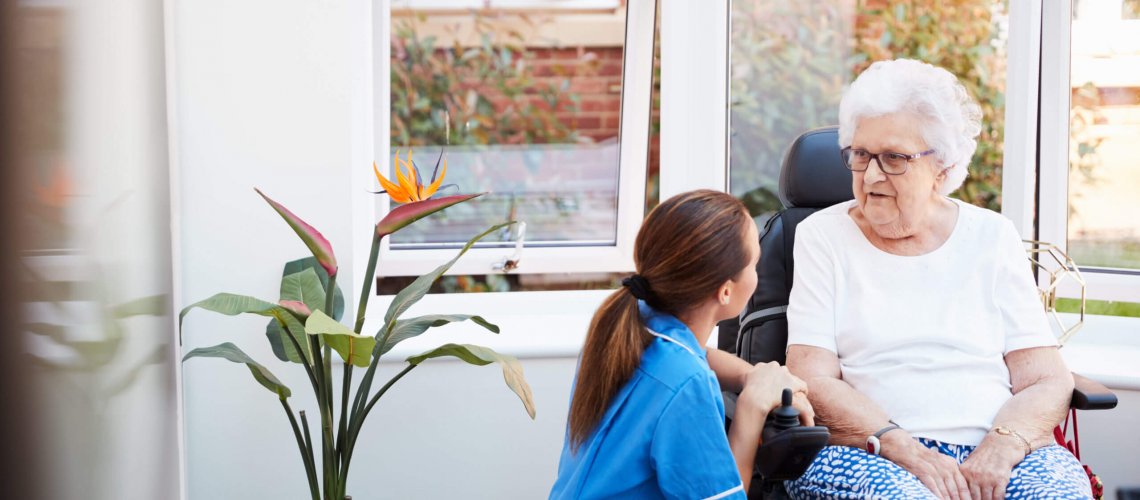One of the challenges faced by senior living community managers is maintaining a balance between providing residents with independence, and ensuring safety, well-being, and access to assistance when they need it most. Older adults typically do not want to feel like they’re being monitored or “babysat,” but families (and the professionals they turn to for help) want peace of mind that their loved ones aren’t on their own during an emergency.

Emergency call systems for assisted living communities can help bridge the gap between independent living and safety. When your residents know they can reach help any time they fall, have a medical issue, or simply need assistance or an answer to a question, everyone benefits. But how do you choose the perfect emergency call system for your assisted living community?
How an Emergency Call System Benefits Your Community
In senior living communities, an emergency call system that ensures fast, responsive communication can mean the difference between life and death when seconds count. Choosing a dependable, easy-to-use system can make a difference to all of the stakeholders in your organization, including:
- Residents, who feel safer and more secure knowing they can reach help whenever they need it, while still maintaining a certain degree of independence and privacy.
- Families, who have peace of mind knowing that their loved ones are being cared for and protected.
- Staff, who can reach people in need more quickly, and provide personalized service when residents need non-emergency assistance.
- Leadership, who can feel more confident that they are meeting the needs of their residents and families, and providing the highest quality care and living environment.
Advanced emergency call systems for assisted living also provide data and tools that leaders can use to improve care and service, while also better managing the challenges that come from overseeing senior care communities. A call system can help track how efficient staff is when answering resident calls, what residents need the most help with, and provide important data for families about their loved one’s care and well-being.
Choosing the Right Emergency Call System for Assisted Living
Many people associate emergency call systems with the medical alert necklaces advertised on television, or the call button systems used in hospitals. Both of these options, while useful, often have associated stigmas for these residing in senior living communities. Independent adults aren’t always accepting of devices that leave them feeling elderly or frail, no matter how useful those tools may be.

With that in mind, assisted living managers should focus on several key factors when selecting an emergency response system. These include:
- Maintain resident dignity. Older emergency call systems for assisted living have an institutional appearance, which is often intrusive. Your residents want an inconspicuous system that blends in with the surroundings and isn’t industrial or institutional-looking, which helps preserve their dignity.
- Use wireless technology. Modern emergency response systems are wireless, and use existing WiFi infrastructure to keep your staff and residents connected.
- Allow two-way communication. Older emergency call systems in senior living environments typically only allow one-way communication, alerting staff to an issue that they then need to investigate. A more effective system allows for two-way communication between your staff and residents, which can improve response times and service.
- Implement voice-activated technology. Active, independent seniors aren’t interested in call systems that use pull cords, buttons, and sensors. A wireless call system that allows them to request assistance using voice-activated technology is preferable.
- Offer customization. Every resident of a senior living community has different needs and expectations — and that includes expectations surrounding emergency response systems. A system that can be customized for individual preferences and needs —for example, one that allows them to make calls to the community staff, local EMS, or family as needed— keeps residents in control.
Keeping residents safe is just one priority for you as a senior community leader. You have other challenges, from keeping residents and their families informed to providing health management services. HandsFree Health understands these challenges. The company was founded by a team of former healthcare executives, and provides solutions tailored to real needs.
Beyond Emergency Response with WellBe
HandsFree Health’s collection of personal emergency response devices —the WellBe Smart Speaker, Smartwatch, and the new Pendant— are more than your typical medical alert devices. These full-featured, wireless, voice-activated devices allow active seniors to stay in control of their lives and their well-being.

The WellBe Smart Speaker, for example, is a voice-activated virtual assistant that not only allows users to call for help but also provides reminders, answers to health-related questions, and access to entertainment, news, and weather. The speaker itself is small and inconspicuous, without any indication that it’s a medical alert device.
The same applies to the WellBe Smart Watch and Pendant. The SmartWatch, which serves as a pedometer, heart rate monitor, and GPS location device in addition to a two-way communication device, has a modern, streamlined design. The GPS-enabled Pendant is just over one-inch square, making it an inconspicuous option for those who want the peace of mind of being able to reach help anytime, anywhere.
HandsFree Health’s emergency response options check all the boxes for senior living communities. The devices can easily be set up to each individual’s needs, and thanks to the companion mobile app, families can be kept in the loop as well.
Powerful Assisted Living Solutions with HandsFree Health
To learn more about how you can implement HandsFree Health technology into your senior living community and improve your operations and the resident experience, download our free guide “The Senior Living Community Guide to Senior-Focused Technology”. Created for communities like yours, this complimentary guide shows you how the WellBe® Voice-Assisted Healthcare Smart Speaker can solve some of your most pressing problems and keep your community safe.
